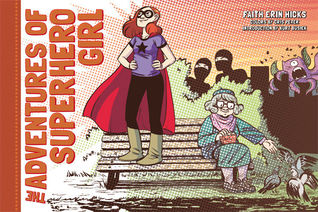The Adventures of Superhero Girl
Faith Erin Hicks
This unexpected treat I found in the children's section of Cardiff Central Libraries, during a day I spent "researching" the resources there. (I was finding materials for story time and got distracted in the graphic section.)
Superhero Girl is a completely terrible superhero, especially compared to her brother, who takes on the world and handles the fame of his status with ease and composure.
And yet it is Superhero Girl that I would like to be - terrible with romance, impoverished by lack of income, and pretty useless at maintaining her secret identity. Her missions are somewhat mediocre - rescuing cats from trees, placating her overzealous mother, etc. - but that makes it all the more brilliant when her arch-nemesis finds himself chosing between continuing in a career of evil and a more conventional profession.
This comic stemmed from a blog, which you can find here: http://superherogirladventures.blogspot.co.uk/; and author Faith Erin Hicks is very vocal and entertaining on social media. She is definitely worth following.
The Hare with the Amber Eyes
Edmund de Waal
I am not much of a reader of biographies - only those of specific individuals I admire. But in order to see how Cardiff librarians run their book clubs, I thought I would read this and attend the meeting at Cathays.
Edmund de Waal has a fascinating family history, spanning many nations, and measured in this book by the presence of netsuke, small Japanese figures collected by his ancestors. They are initially collected by Charles Ephrussi, a Russian immigrant in Paris, at the height of their popularity. The figures move from here, to Vienna, to England and finally back to Japan with de Waal's uncle, Iggy.
I really enjoyed reading through the context of the journey - learning the details of the Ephrussi's attempts at assimilation into Vienna between the wars, and their eventual exclusion from the city during the Nazi reign. They were an incredibly adaptable family, spreading themselves through Europe and later into South America and the far East. And yet, despite their best efforts, anti-Semitism was too ripe to bring the family peace.
Some elements of the story seemed too good to be true - many of the family's fortunes came thanks to their wealth, but the survival of the netsuke was incredible. During the Nazi occupation, the Ephrussi household was taken over by the Nazi bureaucracy, and their property was scattered amongst the Ayrian elite. But the netsuke escaped attention, and were smuggled to safety in the folds of the apron of the family maid.
I would have liked to have learned more about de Waal's grandmother, Elisabeth. She was the daughter of the glamorous Baroness Emmy, a fashionable, sophisticated woman - but unlike her mother, Elisabeth had little fashion sense and was a determined, academic young woman. She fought for her education, and later fought to get her family out of Vienna during the Second World War. And after the war, she fought to regain possession of all the art and property her family lost during the Nazi occupation. I admired Elisabeth, a woman who seemed completely ahead of her time.
The end of the novel left me wondering what might happen next to the netsuke and to the Ephrussi family, now diluted by marriage and spread across the world.
Howl, Kaddish, and other poems
Allen Ginsberg
Andrew McMillan is the reason for me reading Allen Ginsberg - I am just ashamed that it has taken me so long!
Reading this so soon after finishing Kerouac has slightly messed with my brain - I am starting to feel like part of the Beat Generation, like a young, disillusioned man, endlessly searching for truth and honesty and beauty.
Even now, Ginsberg's style seems unconventional - it must have shocked and awed when first published - with it's long, winding sentences, peculiar line breaks, and complete disregard for standard meter.
But all this adds to Ginsberg's power. He is angry and passionate and contemporary, though some of his words resonate with society today.
The images in Ginsberg's poetry are vivid and mesmerising. I can picture him sitting in a coach station on "great wooden shelves and stanchions posts and beams assembled floor to roof jumbled with baggage"; I see Ginsberg bent over his typewriter, wondering if his audience of the future "will [...] eat my poems or read them".
As I read 'Kaddish', I was gripped by Ginsberg's depth, his love for his mother and his battle between the guilt and the responsibility he feels. My heart broke for his strength through such adversity.
But the poem I loved most was 'Sunflower Sutra', an account of a day spent with his friend, Jack Kerouac, mulling over the beauty of the tiny details in the world around them; finishing in a loud, uplifting call to arms:
"we're all beautiful golden sunflowers inside."
